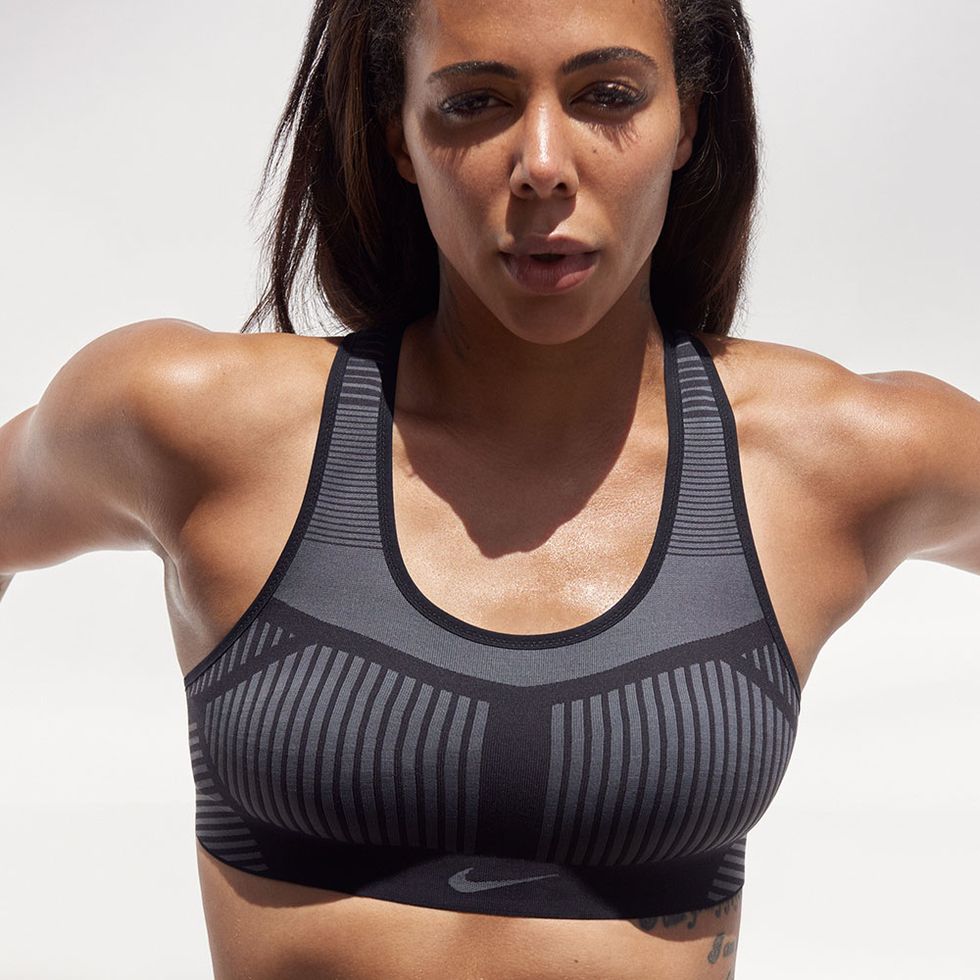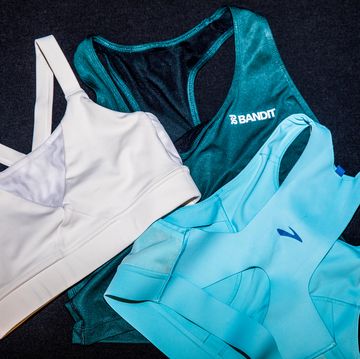“I’ve always been obsessed with bras,” Nicole Rendone says. As a runner, she’s sometimes struggled to find a sports bra that’s supportive yet comfortable, and there were years when she would wear three bras at a time so she could aggregate their various features.
Now, as senior innovation designer for Nike’s women’s training line, she’s about to unveil an item she’s personally been longing for: the FE/NOM Flyknit Bra.
“We think this bra is going to revolutionize the market,” Rendone says.
In the past, Nike’s bras haven’t exactly qualified as revolutionary. But as capable versions of tried-and-true bra designs, they’ve performed well in our annual tests. (See Runner’s World sports bra reviews here, The Best Sports Bras With Pockets for Storage August issue for the latest reviews. The Nike bra was not released in time to be included in the August issue.)
The new FE/NOM, which is available on Nike+ today and on nike.com on Friday, aims to offer something truly new. I spoke with several Nike staffers involved in the development of the bra, and I took it out for a quick test run.
The bra's origins are in shoes. Nike used the techniques it had developed for its The bras origins are in shoes. Nike used the techniques it had developed for its and applied them to bra design. “Our goal with Flyknit was to make footwear that feels invisible—like nothing—but that still offers support,” says Andy Caine, vice president of footwear design. That’s exactly what women want from a sports bra.
Nike says its proprietary knitting machines can create fabric that’s so stiff and supportive, it can replace traditional bra parts—like an underwire. The technology can also merge supportive zones with ones that are stretchier (for comfort) or more breathable (for moisture management). Those various zones get knitted together without the need for seams or layers of fabric (many bras, like shoes, stack up multiple layers of material to create supportive areas that contain movement). Stacked layers inhibit breathability. And every seam has the potential to create friction and chafing.
Related: See how you can find the proper sports bra for you:
Thus the Flyknit bra has just two seams, and only one layer of fabric (most high-impact sports bras stack or stitch together 41 to 55 separate components). And unlike existing seamless running bras, which are only supportive enough for A and B cup runners, the FE/NOM promises to serve D-cup runners.
To do that, the FE/NOM employs an “underwire” of non-stretchy, stabilizing fabric between and beneath the breasts to reduce bounce. And knitting (instead of a molded foam panel) creates individual cups that not only prevent the dreaded uniboob look, but also encapsulate breasts to further limit movement. A strip of open mesh along the spine boosts breathability in this notoriously sweaty zone. “It looks strikingly simple, given how much technology has gone into this bra,” Rendone says.
Perhaps the biggest clue to the bra’s built-in innovation is the price tag. At $80, the FE/NOM is a lot more expensive than your typical pullover.
And does it offer significantly more support? Curious to find out whether this minimalist racerback would actually support my 34C breasts while running, I took to the track.
Initially, I’m struck by the Flyknit’s satiny fabric. It has a markedly smoother hand than most bras I’ve tested, so I would trust it not to chafe on long runs. It conforms nicely to my body, and it feels comfortable but snug—particularly in the bottom band, which is responsible for the majority of any bra’s support.
RELATED: 8 Running Headbands That Never Slip Off
I try some short sprints and do a few rounds of jump squats. No discernible bounce. Then I head to a trail, and settle into a moderately-paced run. The bra feels so unobtrusive that it simply fades from focus. I have to keep reminding myself to resume my evaluation: How’s the support? How does it feel?
My conclusion: It’s just as supportive as more elaborately structured bras that employ multiple clasps, metal wires, more foam—but with less imposition. I really like that.
The bra also promises to perform well for runners with larger breasts. Senior research scientist Bridget Munro showed two videos side by side: One depicts a woman (size 36DD) running in the FE/NOM. In the other, the same runner wears the Nike Pro Rival bra. To my eye, the model’s breasts bounce a lot more in the Pro Rival. “Is that also your interpretation?” I ask.
Munro hesitates. She doesn’t want to go on record as saying that the Pro Rival permits an undesirable amount of breast movement. What she does say is that her lab’s motion-capture technology confirms the Flyknit’s bounce-banishing powers.
“We’ve had large-breasted runners come in here and when they see the bra, they say, ‘There’s no way this is going to work for me,’” Munro says. The bra looks too simple, too light—too much like other pullovers that have failed to offer sufficient support for C+ sizes. “But when they try it,” Munro says, “They fall in love.”
I can understand why. Sports bras that are built for larger breasts tend to be stiff and sweat-trapping. By offering equivalent support in a simpler, lighter design, Nike is likely to win a lot of converts, particularly among the C+ crowd.
I’m eager to test the bra on longer runs, over a longer period of time—and to see what future iterations of the FE/NOM will do. Adjustable versions in band/cup sizes are in development. But for now, I’d say the debut model is well worth checking out.
Freelance writer Kelly Bastone reviews sports bras for Runner's World.















